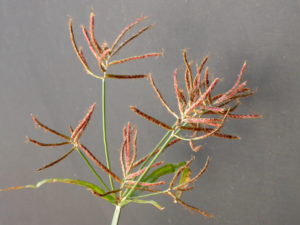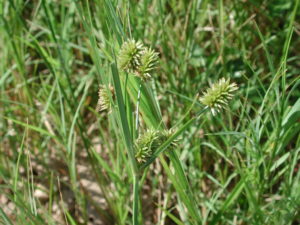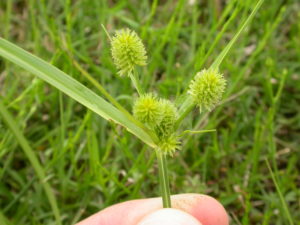Yellow Nutsedge (Cyperus esculentus) is often referred to as nutgrass or watergrass. Yellow nutsedge is a perennial plant that reproduces primarily by small underground tubers (called nutlets) that form at the end of underground stems (rhizomes). A single plant can produce several hundred of these tubers throughout the summer. Yellow nutsedge can also spread by rhizomes.
Yellow nutsedge can be identified by the triangular shape of its stem as can all sedges. You can feel the shape by rolling the stem in your fingertips. One method of control is to grow a healthy, dense, vigorous stand of forage that can compete with weeds. Encourage dense forage stands by following proper forage management practices, including fertilization, and proper grazing management. Yellow nutsedge as well as other sedges thrive in areas where soils remain moist from poor drainage or excessive rainfall. However, sedges can also be a problem in well-drained areas, especially in areas of thin/weakened forage production.
Purple Nutsedge (Cyperus rotundus) is a perennial with rhizomes and contains an inflorescence similar to yellow nutsedge however it’s more of a purple color than yellow. reproduces primarily by small underground tubers (called nutlets) that form at the end of underground stems (rhizomes). A single plant can produce several hundred of these tubers throughout the summer. Purple nutsedge can also spread by rhizomes.
Globe Flatsedge (Cyperus echinatus) is a perennial with rhizomes and contains an inflorescence with green globe shaped balls. Commonly found in poorly drained soils. Leaves are sharply triangular in cross-section with concave sides. Leaf blades are very glossy and hairless. The seedhead is the most obvious characteristic that distinguishes globe flatsedge from similar sedge species. The seedhead consist of green and globe shaped flowers, usually in clusters containing 1-3 globes.
Select Herbicide Options:
Roundup (glyphosate)
Outrider (for bermudagrass pastures and hay meadows, bahiagrass can be injured)
REMEMBER: THE LABEL IS THE LAW! Always read the pesticide label before using.
Vanessa Corriher-Olson
Professor, Forage Extension Specialist
Soil & Crop Sciences
Texas A&M AgriLife Extension, Overton,TX
903-834-6191




